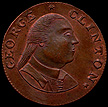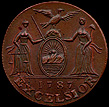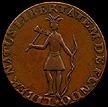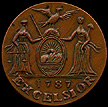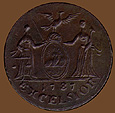Machin's 1787 Patterns
Bolen Reproductions
obverse |
|
reverse |
| |||
1787 Bolen reproduction of the Clinton Pattern
Obverse: GEORGE * CLINTON *
Reverse: 1787 / EXCELSIOR
Weight: 158.6 g (10.28 grams) Diameter: 27 mm Reverse die alignment: 180°
Comments: This is a well preserved example of the reproduction of the Clinton pattern produced in 1869 by John Bolen. The obverse of this reproduction can be identified by the dot in the center of the O of George, added by Bolen to distinguish it from the original.
The reverse can be distinguished in several ways. The upper left corner of the first E in EXCELSIOR touches the baseline and is slightly to the right of the foot on the figure of Justice. On the original the corner of the E is directly under the foot. Also, in the center of the seal is the rising sun in a double oval frame. On the reproduction the outer oval is incomplete stopping at the first baseline on the right and at the second baseline on the left side, while on the original the outer oval is complete (with the upper baseline stopping where it meets the oval). Additionally the sun has fifteen rays in the reproduction while in the original the sun has thirteen rays. Also, Breen has pointed out that in the date the tops of the 78 are at the same height in the reproduction but on the original the 8 is higher. This reverse is also used in the following example of the Liber Natus pattern.
Provenance: Acquired through the Robert H. Gore, Jr. Numismatic Endowment from EANA auction of November 16, 1996, lot 176.
obverse |
|
reverse |
| |||
1787 Bolen reproduction of the Liber Natus Pattern
Obverse: LIBER NATUS LIBERTATEM DEFENDO *
Reverse: 1787 / EXCELSIOR
Weight: 158.9 g (10.29 grams) Diameter: 26.7 mm Reverse die alignment: 170°
Comments: This is a reproduction of the LIBER NATUS copper produced in 1869 by John Bolen. The obverse can be distinguished in several ways. The left foot of the Indian (which is on the viewer's right) touches the ground line on the reproduction while on the original the line narrows to a point just before reaching that foot. Also, the two A's in the legend are complete on the reproduction but on the original they are broken at the top of the thinner of the two lines. In DEFENDO the ND are the same height on the reproduction while on the original the top of the N lacks a serif and so is lower than the top of the D. Finally, the original only has seven feathers in the headdress whereas the reproduction has more. See the following item to compare this reproduction with a cast copy made directly from an original coin.
The reverse can also be distinguished in several ways. The upper left corner of the first E in EXCELSIOR touches the baseline and is slightly to the right of the foot on the figure of Justice. On the original the corner of the E is directly under the foot. Also, in the center of the seal is the rising sun in a double oval frame. On the reproduction the outer oval is incomplete stopping at the first baseline on the right and at the second baseline on the left side, while on the original the outer oval is complete (with the upper baseline stopping where it meets the oval). Additionally the sun has fifteen rays in the reproduction while in the original the sun has thirteen rays. Also, Breen has pointed out that in the date the tops of the 78 are at the same height in the reproduction but on the original the 8 is higher. The same reverse was used in the previous example of the Clinton pattern.
Provenance: Acquired through the Robert H. Gore, Jr. Numismatic Endowment from EANA auction of January 17, 1997, lot 654.
Cast Copy from an Original Coin
obverse |
|
reverse |
| |||
1787 Cast copy of the Liber Natus Pattern
Obverse: LIBER NATUS LIBERTATEM DEFENDO *
Reverse: 1787 / EXCELSIOR
Weight: 160.6 g (10.40 grams) Diameter: 27.95 mm Reverse die alignment: 180°
Comments: This is a cast copy made from an original coin. On the obverse the seven headdress feathers are not all equally visible. To the left are two large feathers with a small one that is only partly visible between them, there is one feather faintly visible in the center and then three additional feathers are found to the right. In the legend note the use of the "broken A" in which the thin ascending line breaks before joining at the top of the letter.
On the reverse note the sun has thirteen rays and that in the date 1787 the 8 is large, the top of that number is higher than the seven on either side of it. See above for other details on the Bolen reproduction and the introduction for a discussion of the imagery.
Provenance: Acquired through the Robert H. Gore, Jr. Numismatic Endowment from EANA auction of May 23, 1998, lot 655.
| Brasher's Doubloons | Section Contents | NYC Imitation British Halfpence |
|
For viewing tips and information on optimal computer settings click
here.
For questions or comments contact Special Collections by: |
